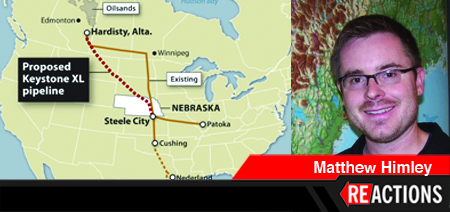President Barack Obama is expected to veto legislation on the Keystone XL Pipeline. Though the move came as no surprise, it is notable that the project has captured so much attention, says Assistant Professor of Geography Matthew Himley, who studies extractive industry politics in South America. (Himley can be reached via MediaRelations@IllinoisState.edu)
Himley:
What’s fascinating about Keystone XL is how this seemingly mundane infrastructure project has brought to the fore so many social, economic, environmental and geopolitical concerns. This isn’t the first oil pipeline to come from Canada through the United States; several oil pipelines even run through Illinois. Yet this project – which would facilitate the transport of crude oil from the oil sands of Alberta, Canada to refineries along the U.S. Gulf Coast – has taken on a great deal of importance for the environmental movement, and within the broader political system.
The U.S. environmental movement has mobilized around the proposed pipeline, and made it a focal point for climate activism. From environmentalists’ perspective, Keystone XL has become a symbol for all that is wrong with our unsustainable, fossil fuel-based energy system, which is responsible for high levels of greenhouse gas emissions and, in turn, climate change. Their view is that Keystone XL would only serve to deepen our dependence on oil – and, in particular, “dirty” oil from the oil sands – at a time when we should be fully focused on developing low-carbon energy sources, like wind and solar.
As a geographer who has studied the social and environmental impacts of large-scale extractive projects, I am concerned about the techniques used to extract and process the oil sands of Alberta. Oil sands are an “unconventional” oil resource. While “conventional” oil is liquid enough in consistency to be pumped directly from the ground, Alberta’s oil sands are a highly viscous mixture of sand, clay, water and a heavy hydrocarbon known as bitumen. Extracting this stuff typically requires huge extents of land to be cleared and massive amounts of material to be moved. The landscape transformations can be stark, and large areas of boreal forest have been impacted. Meanwhile, a great deal of energy – much of which comes from natural gas – is needed to process oil sands into synthetic crude, making the oil sands an especially carbon-intensive energy source. Finally, these production processes also require large water inputs, and communities downstream from oil sands operations have raised significant concerns about water contamination
Arguments for the pipeline have centered on jobs and energy security. While estimates regarding Keystone XL’s job-creation benefits have varied, it’s generally acknowledged that pipeline construction would generate thousands of jobs (tens of thousands if “indirect” job creation is considered). Yet the vast majority of these would be short-term. Indeed, the State Department has estimated that the pipeline, once built, would require only 35 permanent employees. Proponents also say that the pipeline would increase the amount of oil coming into the U.S. from a stable, “friendly” nation, as opposed to from countries in the Middle East, or Venezuela, the result being greater energy security. (The U.S. already imports around 940 million barrels of oil annually from Canada, more than we import from all Persian Gulf countries combined.) Critics point out, however, that much of the oil that would be sent via Keystone XL to Gulf Coast refineries could bypass the U.S. market altogether and be exported to consumers around the world.
Interestingly, the recent drop in the price of oil – which is down about 60 percent since June – is reshaping political debates about Keystone XL. For one, there is evidence that cheaper gas prices have reduced political pressure in Washington to approve the pipeline. Lower prices for oil also change how we think about Keystone XL’s climate impacts.
Proponents have long argued that the pipeline would not lead to increased greenhouse gas emissions because, even without Keystone XL, Alberta’s oil sands would be developed, with oil being shipped to market in some other way, most likely by rail. The State Department drew similar conclusions in an early 2014 report on the project. However, the EPA recently wrote to President Obama arguing for the need to revisit these conclusions. Given the higher costs of alternative shipping methods, like rail, the agency suggested that if Keystone XL were not built, lower oil prices could in fact lead to less oil sands development. The implication is that by rejecting Keystone XL, the Obama administration would effectively be keeping a large amount of carbon in the ground.

